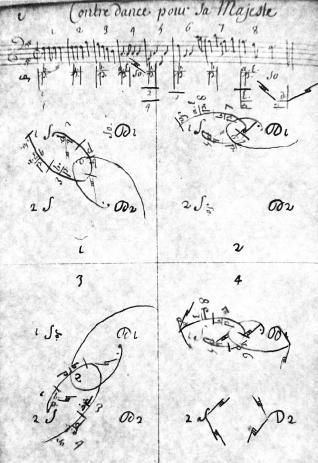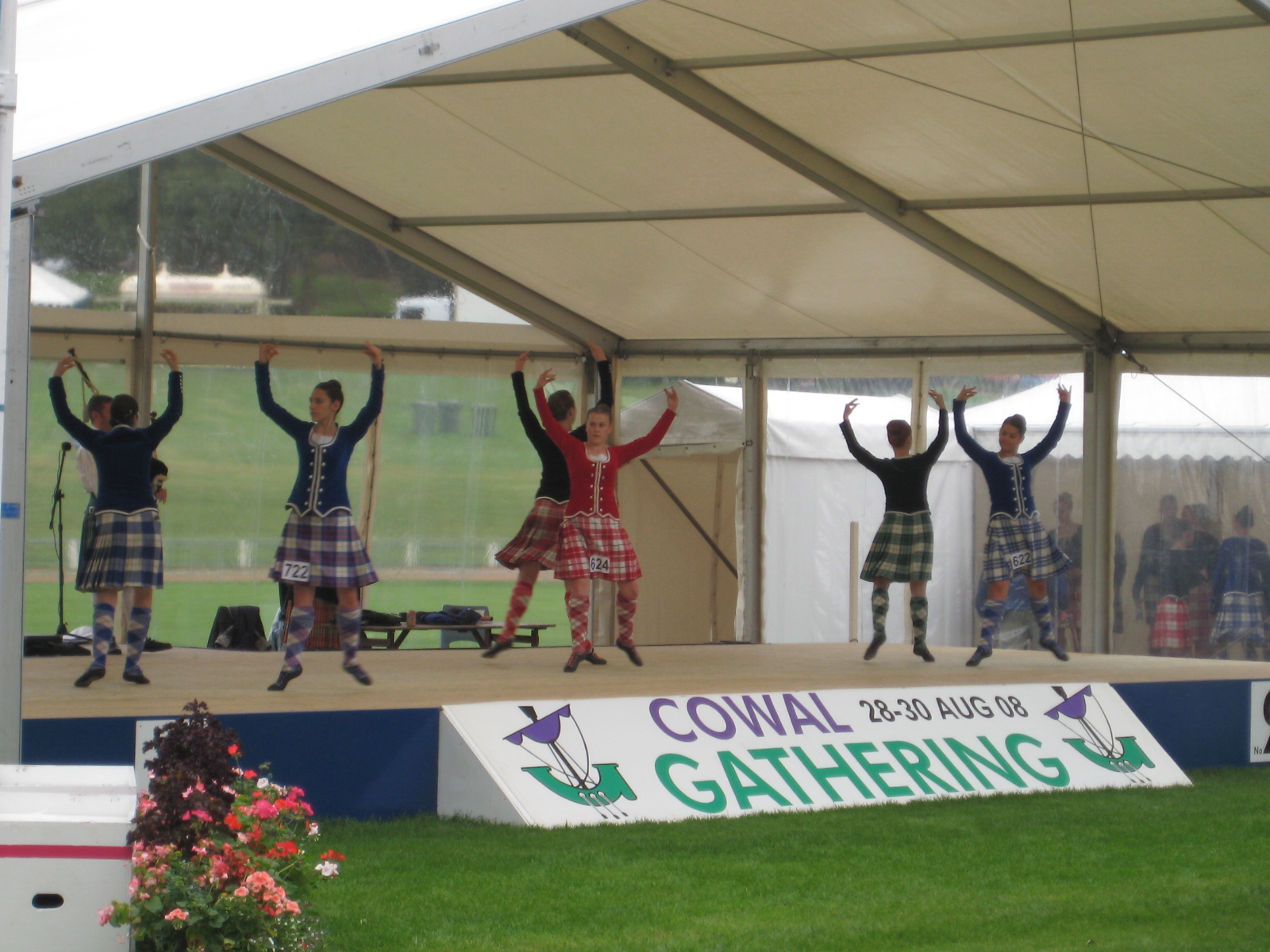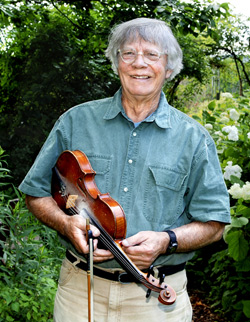|
Dosado
Do-si-do is a dance move. Description It is a circular movement where two people, who are initially facing each other, walk around each other without or almost without turning, i.e., facing in the same direction (same wall) all the time. In most cases it takes 6–8 counts to complete. The movement is basically defined by as follows: * dancers advance and pass right shoulders, * without turning each dancer moves to the right passing in back of the other dancer. At this moment the partners face away from each other, * then moving backwards dancers pass left shoulders returning to starting position. The actual steps vary in specific dances. Considering the amount of space in which to accomplish the figure, the partners might adjust their shoulders slightly diagonally to allow for less sideways movement during the shoulder passes. The advancing pass may also be by the left shoulders, although it will be called as a "left do-si-do" or a "see-saw". While executing this move, women ... [...More Info...] [...Related Items...] OR: [Wikipedia] [Google] [Baidu] |
Glossary Of Partner Dance Terms
This is a list of dance terms that are not names of dances or types of dances. See List of dances and List of dance style categories for those. This glossary lists terms used in various types of ballroom partner dances, leaving out terms of highly evolved or specialized dance forms, such as ballet, tap dancing, and square dancing, which have their own elaborate terminology. See also: * Glossary of ballet terms * Glossary of dance moves Abbreviations *3T – Three Ts *CBL – Cross-body lead *CBM – Contra body movement *CBMP – Contra body movement position *COG – Center of gravity *CPB – Center point of balance *CPP – Counter promenade position *DC – Diagonally to center *DW – Diagonally to wall *IDSF – International DanceSport Federation *IDTA – International Dance Teachers Association *ISTD – Imperial Society of Teachers of Dancing *J&J – Jack and Jill *LOD – Line of dance *MPM – Measures per minute *NFR – No foot rise *OP � ... [...More Info...] [...Related Items...] OR: [Wikipedia] [Google] [Baidu] |
Russian Folk Dance
Russian folk dance (russian: Русский народный танец) is an important part of Russian culture. Some of the unique characteristics suggest that many elements were developed by the early Russian population. History Many Russian dances became known from the 10th century. Russia witnessed various invasions from other countries. Due to its location and size the country also came into contact with many different cultures through migration and trading. In turn, a Eurasian cultural mix of music and dance helped develop Russian folk dances. Many of these early dances were performed and practiced by the lower classes. Typically the upper classes would watch performers rather than participate in the dances themselves. The original Russian folk dance traditions continue to play an important part in the culture of the country and have been in constant interaction with Russia’s many ethnic groups. Russian folk dances are also in interrelations with other types of artisti ... [...More Info...] [...Related Items...] OR: [Wikipedia] [Google] [Baidu] |
Corruption (linguistics)
Language change is variation over time in a language's features. It is studied in several subfields of linguistics: historical linguistics, sociolinguistics, and evolutionary linguistics. Traditional theories of historical linguistics identify three main types of change: systematic change in the pronunciation of phonemes, or sound change; borrowing, in which features of a language or dialect are altered as a result of influence from another language or dialect; and analogical change, in which the shape or grammatical behavior of a word is altered to more closely resemble that of another word. All living languages are continually undergoing change. Some commentators use derogatory labels such as "corruption" to suggest that language change constitutes a degradation in the quality of a language, especially when the change originates from human error or is a prescriptively discouraged usage. Modern linguistics rejects this concept, since from a scientific point of view such inn ... [...More Info...] [...Related Items...] OR: [Wikipedia] [Google] [Baidu] |
French Language
French ( or ) is a Romance language of the Indo-European family. It descended from the Vulgar Latin of the Roman Empire, as did all Romance languages. French evolved from Gallo-Romance, the Latin spoken in Gaul, and more specifically in Northern Gaul. Its closest relatives are the other langues d'oïl—languages historically spoken in northern France and in southern Belgium, which French ( Francien) largely supplanted. French was also influenced by native Celtic languages of Northern Roman Gaul like Gallia Belgica and by the ( Germanic) Frankish language of the post-Roman Frankish invaders. Today, owing to France's past overseas expansion, there are numerous French-based creole languages, most notably Haitian Creole. A French-speaking person or nation may be referred to as Francophone in both English and French. French is an official language in 29 countries across multiple continents, most of which are members of the ''Organisation internationale de la Francophonie'' ... [...More Info...] [...Related Items...] OR: [Wikipedia] [Google] [Baidu] |
Vis-à-vis
{{disambiguation ...
Vis-à-vis may refer to: * Vis-à-vis, a French expression in English, literally "face to face (with)", meaning in comparison with or in relation to * ''Vis-à-vis'' (album), by Karol Mikloš, 2002 * Vis-à-vis (carriage), a type of horse-drawn carriage * ''Vis a vis'' (TV series), a Spanish TV series * "Vis à Vis" (''Star Trek: Voyager''), an episode of the TV series See also * Viz (other) Viz may refer to: *''viz.'', a synonym for “namely” *Viz (comics), ''Viz'' (comics), a British adult comic magazine **''Viz: The Game'', a computer game based on the comic *Viz Media, an American manga and anime distribution and entertainment ... [...More Info...] [...Related Items...] OR: [Wikipedia] [Google] [Baidu] |
Modern Western Square Dance
Modern western square dance (also called western square dance, contemporary western square dance, modern American square dance or modern square dance) is one of two American types of square dancing, along with traditional square dance. As a dance form, modern western square dance grew out of traditional square dance in the American West. The term ''western square dance'', for some, is synonymous with "cowboy dance" or traditional western square dance. Therefore, this article uses the term "modern western square dance" to describe the contemporary non-historical dance which grew out of the traditional dance. Modern western square dance was the official dance of the United States from 1982 to 1993. Modern western square dance, like traditional square dance, is directed by a '' caller''. In modern western square dance the caller strings together a sequence of individual '' square dance calls'' to make a figure or sequence. These calls are the building blocks of the choreography t ... [...More Info...] [...Related Items...] OR: [Wikipedia] [Google] [Baidu] |
Callerlab
CALLERLAB is the international association of modern western square dance callers, and is the largest square dance association in the United States. After some initial work started in 1971, it was officially established in 1974 by several members of the Square Dance Hall of Fame."The Complete Book of Square Dancing: And Round Dancing", by Betty Casey, 2000, , p. 9 Callers from all over the world, including Saudi Arabia, Japan, Germany, and England, are members of the organization. Functions *Maintains a suggested list of dancing programs, from Mainstream through C-3A. Each program contains a list of standardized square dance calls and concepts, with official definitions. *Provides BMI/ASCAP licensing to its members *Provides liability insurance Liability insurance (also called third-party insurance) is a part of the general insurance system of risk financing to protect the purchaser (the "insured") from the risks of liabilities imposed by lawsuits and similar claims and prot ... [...More Info...] [...Related Items...] OR: [Wikipedia] [Google] [Baidu] |
American Callers Association
The American Callers Association (ACA) is the second largest association of square dance callers in the United States. ACA is a non-profit organization with headquarters at Muscle Shoals, Alabama. ACA has members in the United States, Canada, Europe, and New Zealand. Among other things, the organization provides accredited caller training and affordable BMI/ASCAP licensing and liability insurance for dance events. See also *Callerlab CALLERLAB is the international association of modern western square dance callers, and is the largest square dance association in the United States. After some initial work started in 1971, it was officially established in 1974 by several members o ... Square dance Dance organizations Florence–Muscle Shoals metropolitan area {{US-org-stub ... [...More Info...] [...Related Items...] OR: [Wikipedia] [Google] [Baidu] |
English Country Dance
A country dance is any of a very large number of social dances of a type that originated in the British Isles; it is the repeated execution of a predefined sequence of figures, carefully designed to fit a fixed length of music, performed by a group of people, usually in couples, in one or more sets. The figures involve interaction with your partner and/or with other dancers, usually with a progression so that you dance with everyone in your set. It is common in modern times to have a "caller" who teaches the dance and then calls the figures as you dance. Country dances are done in many different styles. As a musical form written in or time, the contredanse was used by Beethoven and Mozart. Introduced to South America by French immigrants, Country Dance had great influence upon Latin American music as contradanza. The ''Anglais'' (from the French word meaning "English") or ''Angloise'' is another term for the English country dance. A Scottish country dance may be termed an . ... [...More Info...] [...Related Items...] OR: [Wikipedia] [Google] [Baidu] |
Genre
Genre () is any form or type of communication in any mode (written, spoken, digital, artistic, etc.) with socially-agreed-upon conventions developed over time. In popular usage, it normally describes a category of literature, music, or other forms of art or entertainment, whether written or spoken, audio or visual, based on some set of stylistic criteria, yet genres can be aesthetic, rhetorical, communicative, or functional. Genres form by conventions that change over time as cultures invent new genres and discontinue the use of old ones. Often, works fit into multiple genres by way of borrowing and recombining these conventions. Stand-alone texts, works, or pieces of communication may have individual styles, but genres are amalgams of these texts based on agreed-upon or socially inferred conventions. Some genres may have rigid, strictly adhered-to guidelines, while others may show great flexibility. Genre began as an absolute classification system for ancient Greek literature, a ... [...More Info...] [...Related Items...] OR: [Wikipedia] [Google] [Baidu] |
Scottish Highland Dance
Highland dance or Highland dancing ( gd, dannsa Gàidhealach) is a style of competitive dancing developed in the Scottish Highlands in the 19th and 20th centuries, in the context of competitions at public events such as the Highland games. It was created from the Gaelic folk dance repertoire, but formalised with the conventions of ballet,Newton, Michael. ''A Handbook of the Scottish Gaelic World''. Four Courts Press, 2000. p.282 and has been subject to influences from outside the Highlands. Highland dancing is often performed with the accompaniment of Highland bagpipe music, and dancers wear specialised shoes called ghillies. It is now seen at nearly every modern-day Highland games event. Highland dance should not be confused with Scottish country dance, cèilidh dancing, or clog dancing, although they too may be performed at Highland games and like competitions. Basic description of Highland dancing Highland dancing is a competitive and technical dance form requiring t ... [...More Info...] [...Related Items...] OR: [Wikipedia] [Google] [Baidu] |
Contra Dance
Contra dance (also contradance, contra-dance and other variant spellings) is a form of folk dancing made up of long lines of couples. It has mixed origins from English country dance, Scottish country dance, and French dance styles in the 17th century. Sometimes described as New England folk dance or Appalachian folk dance, contra dances can be found around the world, but are most common in the United States (periodically held in nearly every state), Canada, and other Anglophone countries. A contra dance event is a social dance that one can attend without a partner. The dancers form couples, and the couples form sets of two couples in long lines starting from the stage and going down the length of the dance hall. Throughout the course of a dance, couples progress up and down these lines, dancing with each other couple in the line. The dance is led by a caller who teaches the sequence of figures in the dance before the music starts. Callers describe the series of steps called "fi ... [...More Info...] [...Related Items...] OR: [Wikipedia] [Google] [Baidu] |




